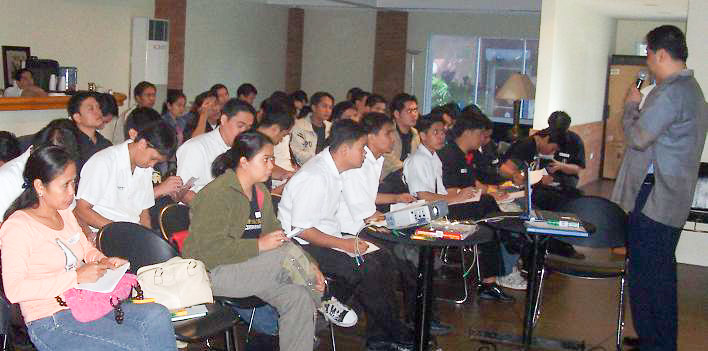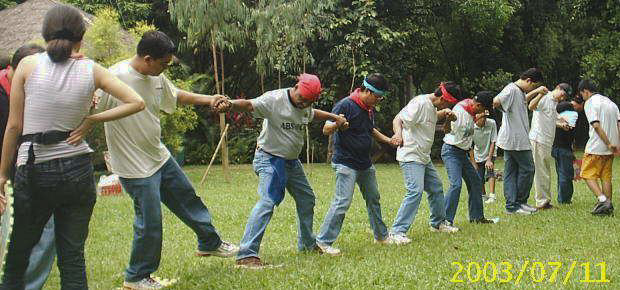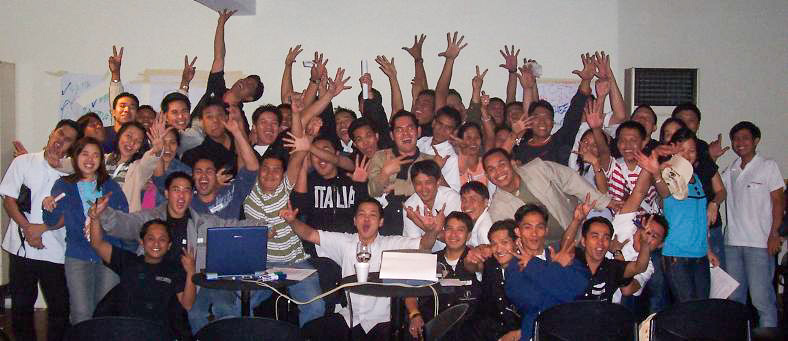
T . O. P : Transforming for Optimal Performance
Build Teams that Work
Building Teams that Work (Building Empowered Teams): Program Design by Michael M. Jacinto, Training Consultant, Dec. 6, 2008 Acquaints members of a newly formed team or helps an intact team learn more about one another. It is very appropriate for groups where people will be working together closely and/or for groups where members will be together for long periods of time.
Objectives :
General:
At the end of the two (2) day teambuilding program, the participants will be able to:
- communicate more comfortably with each other
- determine their areas for improvement
- determine their strength as a team
- relate lessons to the work environment
- realize possibilities to excel
- create a cohesive unified team
- communicate more comfortably with each other
- determine their areas for improvement
- determine their strength as a team
- relate lessons to the work environment
- realize possibilities to excel
- create a cohesive unified team
- determine their areas for improvement
- determine their strength as a team
- relate lessons to the work environment
- realize possibilities to excel
- create a cohesive unified team
Specific:
At the end of the two (2) training day teambuilding program, the participants will be able to:
- develop an environment which is anxiety reducing and allows individuals the opportunity to get acquainted with each other
- help members feel more comfortable with themselves and with others and feel more "at home" in a group by having fun.
- help eliminate tension and distance between people, and make them more relaxed and comfortable with each other.
- demonstrate various aspects of communicating effectively and point out some common communication barriers.
- allow participants to interact with one another in a non-threatening way and lead to good discussions about communication.
- break up the "cliques," by inviting people to form random groupings, and help individuals meet others in non-threatening and creative ways.
- help break down the barriers by having the group provide positive feedback (oral or written or both) and allow members to get to know one another on a more intimate level • create an awareness of real-time issues and concerns and of their responsibilities to the organization
- help participants experience trusting another person with their emotional and physical safety.
- challenge the abilities of a group to take appropriate risks and to provide effective and safe leadership.
- assess your groupmates through indicators about the roles members will play in group situations (thinker, leader, organizer, dominator, follower, etc.)
- understand where the other person is coming from and why he/she acts the way they do, and be able to see things such as who the risk takers are, who the followers are, who the comedian is, and so on; in order to learn to work together by not taking difficult differences so personally.
- explore group/individual accountability, role clarification, decision making, and trust by recognizing the importance of feedback, asking questions, and clarifying concerns
- pull the group together in problem-solving experiences that engage team members towards "start to finish" planning
- establish a system of communication so that everyone in the team knows what to do and when; especially when providing effective support for people coming from various locations
- learn how to work under pressure as a team as well emphasize the need to look for opportunities in an ever-changing business environment • establish bonding and comfortability for teams and workgroups by experiencing teamwork and synergy at a physical, emotional, and behavioral level
- re-establish strained relations in a safe, secure atmosphere
- create better and healthier interpersonal relationships
Course Prerequisites / Requirements :
Prerequisite: None Requirement: Must Complete All Sessions (each topic builds on the next one) Course Delivery: Approach and Methodology
- Interactive Lectures
- Experiential Learning Activities
- Introspection, Insight, and Discovery
- Participative Mode of Learning
- Exercises and Workshops
- Practical: People who have taken these "experiential" training programs attest to improved job performance, quality service, greater self-confidence, and more importantly, better relationships with their co-workers and loved ones.
Who should attend:
This indoor and outdoor in-house workshop training program is highly recommended for all enrolled company personnel from rank-and-file employees all the way to the top management.
Note: Although the teambuilding exercises maintain participants' interest and keep them focused on positive, constructive, and fun activities - emphasize the importance of physical safety to the group. Ask group members to use behaviors that are safe for themselves and for the group.
The challenge by choice approach extends to all levels of the activity. If for any reason a participant is uncomfortable with engaging in a particular challenge there are a number of ways that they can still participate and contribute to the success of the team. Module sequence and content may vary due to the experiential nature of the seminar/workshop. Actual contents are determined by the needs of the participant.
Let's get the team back on track
Don't let your organization's performance suffer. Send us your question or inquiry and we'll get back to you as soon as possible.


